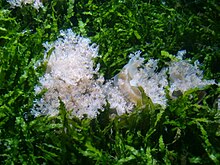This is an old revision of this page, as edited by RN1970 (talk | contribs) at 21:47, 3 August 2012 (tweaks, updated spp. list, rm. repeat). The present address (URL) is a permanent link to this revision, which may differ significantly from the current revision.
Revision as of 21:47, 3 August 2012 by RN1970 (talk | contribs) (tweaks, updated spp. list, rm. repeat)(diff) ← Previous revision | Latest revision (diff) | Newer revision → (diff) Not to be confused with Cassiopeia. This article is about the genus of jellyfish. For the constellation, see Cassiopeia (constellation). For the character in Encantadia, see Cassiopea (Encantadia).
| Cassiopea | |
|---|---|

| |
| Cassiopea sp. | |
| Conservation status | |
 Least Concern (IUCN 3.1) | |
| Scientific classification | |
| Kingdom: | Animalia |
| Phylum: | Cnidaria |
| Class: | Scyphozoa |
| Order: | Rhizostomae |
| Family: | Cassiopeidae Agassiz, 1862 |
| Genus: | Cassiopea Péron & Lesueur, 1810 |
| Species | |
|
8 species, see text | |
Cassiopea (upside-down jellyfish) is a genus of true jellyfish and the only members of the family Cassiopeidae. They are found in warmer coastal regions around the world, including shallow mangrove swamps, mudflats, and turtle grass flats in Florida. The medusa usually lives upside-down on the bottom, which has earned them the common name. Where found, there may be numerous individuals with varying shades of white, blue, green and brown.

They have a mild sting since they are primarily photosynthetic, but sensitive individuals may have a stronger reaction. The photosynthesis occurs because, like most corals, they host zooxanthellae in their tissues. The stinging cells are excreted in a mucus; swimming over these jellies (especially using swim fins) may cause transparent, essentially invisible, sheets of this mucus to be lifted up into the water column, where they are then encountered by unsuspecting swimmers. The stings, appearing in the form of a red rash-like skin irritation, are notorious for being extraordinarily itchy. Sometimes this jellyfish is picked up by the crab Dorippe frascone (family Dorippidae) and carried on its back. The crab uses the jellyfish to defend itself against possible predators.
Species
According to the World Register of Marine Species, this genus includes 8 species:
- Cassiopea andromeda
- Cassiopea depressa
- Cassiopea frondosa
- Cassiopea medusa
- Cassiopea mertensi
- Cassiopea ndrosia
- Cassiopea ornata
- Cassiopea xamachana
References
- "Cassiopeidae". WoRMS. World Register of Marine Species. Retrieved 3 August 2012.
- Murphy, Richard C. (2002). Coral Reefs: Cities Under The Sea. Princeton, New Jersey: The Darwin Press. ISBN 0-087850-138-X.
{{cite book}}: Check|isbn=value: length (help); Invalid|ref=harv(help) - "Cassiopea". WoRMS. World Register of Marine Species. Retrieved 3 August 2012.
External links
- Photo of a Crab carrying an Upside Down Jellyfish (Cassiopea andromeda)
- Bernice Pauahi Bishop Museum entry on Cassiopea andromeda
- A Symbiotic Lifestyle: C. xamachana and Zooxanthellae
This subphylum Medusozoa-related article is a stub. You can help Misplaced Pages by expanding it. |